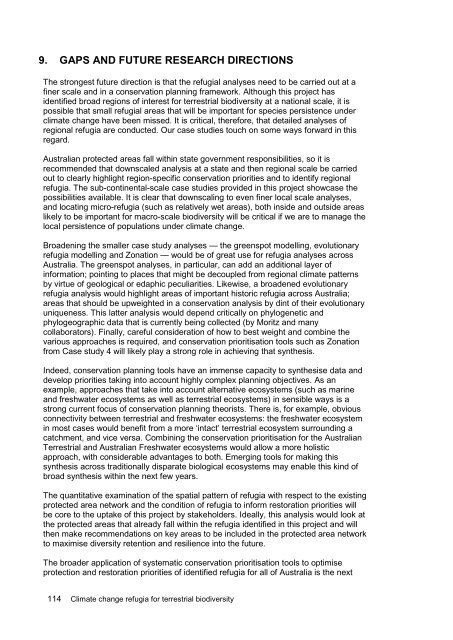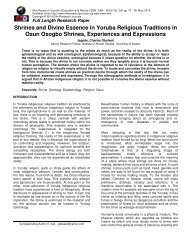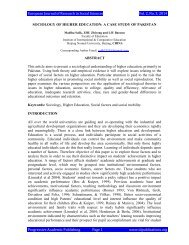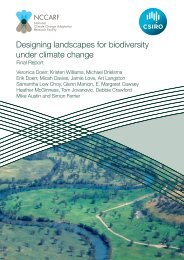Williams-Climate-change-refugia-for-terrestrial-biodiversity_0
Williams-Climate-change-refugia-for-terrestrial-biodiversity_0
Williams-Climate-change-refugia-for-terrestrial-biodiversity_0
Create successful ePaper yourself
Turn your PDF publications into a flip-book with our unique Google optimized e-Paper software.
9. GAPS AND FUTURE RESEARCH DIRECTIONS<br />
The strongest future direction is that the <strong>refugia</strong>l analyses need to be carried out at a<br />
finer scale and in a conservation planning framework. Although this project has<br />
identified broad regions of interest <strong>for</strong> <strong>terrestrial</strong> <strong>biodiversity</strong> at a national scale, it is<br />
possible that small <strong>refugia</strong>l areas that will be important <strong>for</strong> species persistence under<br />
climate <strong>change</strong> have been missed. It is critical, there<strong>for</strong>e, that detailed analyses of<br />
regional <strong>refugia</strong> are conducted. Our case studies touch on some ways <strong>for</strong>ward in this<br />
regard.<br />
Australian protected areas fall within state government responsibilities, so it is<br />
recommended that downscaled analysis at a state and then regional scale be carried<br />
out to clearly highlight region-specific conservation priorities and to identify regional<br />
<strong>refugia</strong>. The sub-continental-scale case studies provided in this project showcase the<br />
possibilities available. It is clear that downscaling to even finer local scale analyses,<br />
and locating micro-<strong>refugia</strong> (such as relatively wet areas), both inside and outside areas<br />
likely to be important <strong>for</strong> macro-scale <strong>biodiversity</strong> will be critical if we are to manage the<br />
local persistence of populations under climate <strong>change</strong>.<br />
Broadening the smaller case study analyses — the greenspot modelling, evolutionary<br />
<strong>refugia</strong> modelling and Zonation — would be of great use <strong>for</strong> <strong>refugia</strong> analyses across<br />
Australia. The greenspot analyses, in particular, can add an additional layer of<br />
in<strong>for</strong>mation; pointing to places that might be decoupled from regional climate patterns<br />
by virtue of geological or edaphic peculiarities. Likewise, a broadened evolutionary<br />
<strong>refugia</strong> analysis would highlight areas of important historic <strong>refugia</strong> across Australia;<br />
areas that should be upweighted in a conservation analysis by dint of their evolutionary<br />
uniqueness. This latter analysis would depend critically on phylogenetic and<br />
phylogeographic data that is currently being collected (by Moritz and many<br />
collaborators). Finally, careful consideration of how to best weight and combine the<br />
various approaches is required, and conservation prioritisation tools such as Zonation<br />
from Case study 4 will likely play a strong role in achieving that synthesis.<br />
Indeed, conservation planning tools have an immense capacity to synthesise data and<br />
develop priorities taking into account highly complex planning objectives. As an<br />
example, approaches that take into account alternative ecosystems (such as marine<br />
and freshwater ecosystems as well as <strong>terrestrial</strong> ecosystems) in sensible ways is a<br />
strong current focus of conservation planning theorists. There is, <strong>for</strong> example, obvious<br />
connectivity between <strong>terrestrial</strong> and freshwater ecosystems: the freshwater ecosystem<br />
in most cases would benefit from a more ‘intact’ <strong>terrestrial</strong> ecosystem surrounding a<br />
catchment, and vice versa. Combining the conservation prioritisation <strong>for</strong> the Australian<br />
Terrestrial and Australian Freshwater ecosystems would allow a more holistic<br />
approach, with considerable advantages to both. Emerging tools <strong>for</strong> making this<br />
synthesis across traditionally disparate biological ecosystems may enable this kind of<br />
broad synthesis within the next few years.<br />
The quantitative examination of the spatial pattern of <strong>refugia</strong> with respect to the existing<br />
protected area network and the condition of <strong>refugia</strong> to in<strong>for</strong>m restoration priorities will<br />
be core to the uptake of this project by stakeholders. Ideally, this analysis would look at<br />
the protected areas that already fall within the <strong>refugia</strong> identified in this project and will<br />
then make recommendations on key areas to be included in the protected area network<br />
to maximise diversity retention and resilience into the future.<br />
The broader application of systematic conservation prioritisation tools to optimise<br />
protection and restoration priorities of identified <strong>refugia</strong> <strong>for</strong> all of Australia is the next<br />
114 <strong>Climate</strong> <strong>change</strong> <strong>refugia</strong> <strong>for</strong> <strong>terrestrial</strong> <strong>biodiversity</strong>






